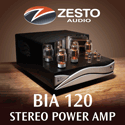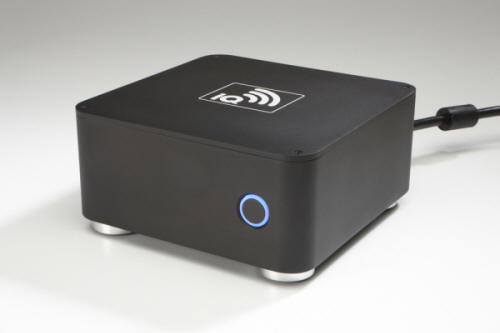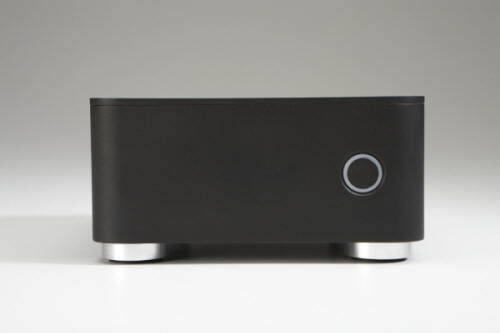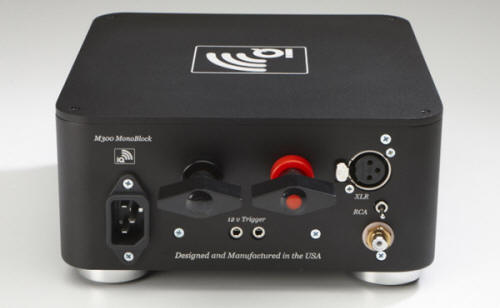|
|
You are reading the older HTML site
Positive Feedback ISSUE 72
iq audio M300 Amplifiers as reviewed by Steve Lefkowicz
One of the hazards of writing over a long period of time is the constant risk (and fear) that you start repeating yourself. Every so often, I find myself realizing that a sentence here or a phrase there is exactly the same as something I wrote some years ago. I suppose it is inevitable that it happens sometimes. After all, there's only so many ways to describe the sound of a piece of audio equipment, but still, I feel like I've let the reader down when it happens. On the other hand, maybe it's arrogant on my part to think that people that read my articles five or ten years ago remember them, or even still read my stuff today. Maybe it bothers me more than anyone else. But still, I don't care much for repeating myself. However, it seems there are certain aspects of reviewing I do have to repeat, fairly often even, just to make sure people who read my reviews understand my biases (we all have them), expectations, and general viewpoint. Sometimes, it seems more important than other times. In the time I spent listening to the IQ Audio M300 mono block amplifiers, and in formulating my ideas and taking notes for this review, it seemed to be one of those times. Why? Well, for one thing, this is the first Class D amp I've ever had in my system. Not that I haven't heard other Class D amps plenty of times before, as Bel Canto, Wyred4Sound and Channel Islands Audio can be heard in systems at any audio show you go to. But no matter how much you hear something somewhere else, it's understandably difficult to pin any characteristics on a single piece in a system that isn't your own.
Secondly, and this will be one of those time where I repeat myself, I really don't care about the technology inside the equipment I review. I know that sounds odd, but I am not reviewing the design or the engineering efforts involved. All I am interested in is how it sounds in my system, and does it seem like good value for sound quality offered(1). I have been very involved in digital imaging systems for many years, and can talk your ear off about DLP, MLVA, VFP, Laser and a variety of other imaging systems, but whenever anyone told me one was "best," I could always come up with a real situation where a different one would be more appropriately implemented. In other words, it's the results, not technology that matter (hey, I've written that before, quite a few times). That holds true for my audio endeavors, too. For example, if you were to ask me whether I prefer tubes or solid-state amplifiers, my honest answer would be whichever sounds better in my system at the time. Over the past many years, the two "best" sounding amplifiers in my system have been a fairly expensive 200-watt MOSFET based solid-state amp and a very inexpensive single-ended 15-watt KT88 tube amp(2). In other words, I can appreciate the strengths and weaknesses of different technologies, and have seen that a good design of any one technology will sound better than a poor design of any other technology. So yes, I have heard good and bad tube amps and good and bad solid-state amps in my system. The one thing I haven't heard, good or bad, in my system is a Class D amp. From a comparison standpoint, that might be an issue, but when all is said and done, as the saying goes, either you can play music or you can't. In general Class D amps do offer a nice alternative to more traditional amplifiers, mostly in terms of size, weight, and efficiency with high power output. The IQ M300, in spite of being a diminutive seven-pound box less than eight inches across or deep, offers up 150 watts into 8 ohms, and a reported 300 watts into 4 ohms. No matter how long I ran them or how loudly I played the system, they never felt more than slightly warm to the touch. Their physical presence won't impress anyone the way an MBL or Jadis amp will, as they're just a couple of nicely finished little black boxes with attractive blue lights to let you know they're powered up. What more do you really need?
The M300 does have some nice and useful features. It can handle both single ended (using nice Rhodium plated Cardas RCA connectors) and balanced inputs, as well as some of the nicest binding posts for your speaker cables that I've run across, regardless of price. The only issue I had was that all three of my primary cables sets(3) were terminated in banana plugs, and the M300 only takes spade connectors. Although my older Nordost Solar Wind speaker cables are indicated as directional, and have been used in that same direction for many years, I had to flip them around and put the speaker end (terminated for bi-wiring with spades) at the amplifier, and plug the bananas into the speaker. Honestly, I don't really think that made any difference. The big handle on the binding post made tightening the cables down to the amp really easy. The amps also came with IQ Audio's IQ-Kord power cord (also sold as an accessory for $65 each). This is a nicely flexible but heavy duty 13 AWG well insulated oxygen free copper power cord with very nice high quality "medical grade" connectors at each end. They seemed well made and were easy to route through the rack to my power conditioner. Yes, I did try some other power cords, generic ones that came with some other amps I had in for review, and again, heard no difference. However, I do appreciate the consideration of supplying such well made power cords with the amps. Like most solid-state amps I've heard over the years, the M300 took a little while to warm up and sound their best. I would suggest waiting at least thirty minutes to an hour after you turn them on, though in my system I left them on all the time. One of the many benefits of Class D operation is that they are extremely efficient, and though IQ Audio doesn't publish an idle power consumption specification, I am guessing it is quite low. So, you ask, how do they sound? Well, like most gear, the answer would be "that depends." In the case of the M300, it seems to largely depend on what speakers you use them with. I'll get more into that later, but first, let me describe the gear I used for this review. Sources were my aging but ever so trustworthy Linn LP12 (Valhalla, Ittok, Dynavector 19A) and my Dell E1505 notebook used as a server, with JRiver Media Center 18. Phono stages were switched between the Jolida JD9 (with all upgrades), the iFi iPhono or the phono section of a PS Audio 4H preamp. DACs for the server included the CEntrance DACport LX, the iFi iDAC, the W4S mDAC or the digital input of the W4S mPRE preamp. All DACs were powered by the iFi iUSB power supply. Preamps used were the W4S mPRE, the Belles Soloist 3, the Jolida Fusion (with upgrades) or my old PS Audio 4H. Speakers were mostly the Tekton Lore, with some time with the SVS Ultra Bookshelf, the Direct Acoustics Silent Speaker and the Sound Dynamics 300ti. Starting with the M300s hooked up to the Tekton Lore, a 98dB efficient speaker with an easy 8-ohm load, I was very impressed right from the beginning. Setting the server to shuffle, over the next couple of hours, I listened for any anomalies that might cause listener fatigue, or irritation. There were none. What I did hear, for my initial impressions, was a very expressive, dynamic, neutral, and lively sound. As efficient as the Tektons are, playing loud is never an issue, and I can shake the walls with five watts. But, feed them more power, and they do get more dynamic and exciting. The M300 spread this dynamic capability evenly across the audible spectrum, favoring neither highs, mids nor low frequencies. From that standpoint these were some of most dynamically coherent amplifiers (especially when pushed hard) I've tried. From that point on it seemed like it would be a simple checklist of characteristics, most of which the M300s expressed none of any great note. This is of course a good thing. The more accurate an amplifier is, the less character it should impart on the signal. Frequency response and tonal balance were very neutral, with nothing deviating enough to be at all noticeable. It was quite extended, digging down deep into the limits of what the Tektons could produce, with control, plenty of authority, and substantial detail. Maybe not quite as deep, powerful and well defined as the ModWright KWI200, but certainly more so than my B&K ST-140 (105-watt, MOSFET). High frequencies were equally well done, with neither the slight grain nor haziness of my old B&K, but also without the absolute transparency of the ModWright, or the airiness of my tube amps. Higher frequencies were, how should I put this, just there, probably very accurately reproduced, just not in any way that I could claim as a characteristic of the amp. Again, this is a good thing. I think most people expect mono block amplifiers to excel at soundstaging and imaging, and the M300 did a fine job in that regard. I did have the opportunity to power the SVS Ultra Bookshelf speakers with them, and images were well defined and respectfully sized within the very expansive stage those speakers can generate. Maybe not quite as large or well defined as those speakers produced with a Jolida JD1000P (100 watt, EL34), but still very nicely done. And so it went, switching between the Tekton Lore and SVS Ultra Bookshelf speakers, I just kept thinking that the M300s certainly do everything well enough, and even maybe exceptionally well. I couldn't really pinpoint any specific flaws or characteristics that would cause me to not want to use them. And that if, at least for me with power amplifiers, is somewhat odd. I usually find describing the sound of power amps fairly easy, as most certainly have enough unIQue and inherent character to be easily heard and described. However, that leads into a little story. I had offered to bring my older original model Direct Acoustics Silent Speakers(4) to my friend Russ Stratten's house in order to invite some friends over and show just how good a $500 speaker could be. Pretty much no one I know has heard these speakers, and a gathering at Russ's house would be an opportunity to let a group of people hear them, since his listening room is much larger than mine. His system is a really fine sounding setup, and he has regular gatherings of friends there to share music and hear other people's gear. One odd thing about the Direct Acoustics speakers is that, for an inexpensive speaker, they are a very difficult speaker to drive. They rate about 83dB, and have an impedance that varies from about 3 to 7 ohms (though listed as 6 ohm nominal). They take a good 100 to 200 watts to sound their best. I usually use my B&K ST140 with them, and it is a surprisingly good combination. However, from a specification standpoint, the IQ M300 looked like they would be an ideal match, so I grabbed them to bring along even though I had not yet tried them together. Probably something to do with their small size and light weight. Needless to say, this little aside would be pointless if everything went according to plan, so of course things didn't quite work out too well. The speakers sounded like they had a blanket over them, produced little usable bass, and sounded, at least compared to how they sound in my system at home, like cheap mid-fi speakers. I was both embarrassed and perturbed. Fortunately, Russ had a set of old, very expensive, prototype Sonorus OTL amps sitting around on loan. Though from a specifications standpoint they should not have worked at all with these speakers, after a 30 minutes warm-up, everything sounded right and the demo went on. I believe the guests were impressed by what the speakers were capable of after that. When I returned home, I immediately set the Silent Speakers up with my B&K to make sure they were in good working order, and they sounded great. Hooked up the M300s and again, not so good. It really is all about system matching(5). To give a further check on the M300 abilities with other speakers, I briefly brought my old Sound Dynamics 300ti in from storage. They are not a difficult load, but are more critical of amplification than the Tekton Lore. The M300 was a beautiful match with those, digging deep in the bass and making the most of the 300tis exceptional titanium tweeter. Vocals and acoustic instruments sounded natural and alive. I've often thought that the 300ti, with appropriate amplification, is like a poor man's Spendor BC-1, as they about the same size and of capable of somewhat similar sound. If not for the having the Tekton Lore handy, I would have kept the 300ti in my system a little longer(6). At the end of the day, I came away from my time with the IQ Audio M300 having great respect for them. They don't really sound like a "conventional" MOSFET or Bipolar solid-state amp, but don't sound at all like a tube amp either. Just as high quality chip amps (like the 47 Labs or more recent Clones Audio amp) have their own sound, these Class D amps have their own sound, too. But, right now, to me they seem quite sonically characterless, and have brought to light some subtle characteristics in my other amps that I hadn't quite identified before. Maybe after I've heard some more Class D amps I'll be better able to more clearly describe the character of the M300s. Matched up to appropriate speakers (they worked great with three of the four speakers I tried them with), they are powerful, neutral, cool running and get pretty much everything right. They are well built and reasonably priced. I think they will put some serious pressure on other manufacturers in this price range. Steve Lefkowicz
M300 Mono Block Amplifiers 2-year warranty, 30-day in-home trial period POWER OUPUT 8-ohms – 150-watts ( maximum power output 250-watts ) 4-ohms – 300-watts (maximum power output 400-watts) All ratings based on FTC test protocol, all rating based on continuous sine wave power / true RMS power Less then 0.02% distortion at any frequency, 20Hz to 20kHz FREQUENCY RESPONSE: 5Hz to 45kHz (– 3 db) POWER SUPPLY: Universal switch mode, Fully protected, Compliant in all countries AUDIO INPUT / INPUT IMPEDANCE: Balanced (XLR) – 100K Ohms, Unbalanced (RCA) – 100K Ohms AUDIO OUTPUT: IQ- torque binding posts AUDIO GAIN: 28dB (standard THX) FEATURES: 12V Trigger, 12V pass through DIMENSIONS: 7.75W X 7.75D X 3.25H (inches), Weight – 7 lbs (1) To be clear, I am not ignorant of the electronics or design involved, have spent the last thirty-five years involved in high-end optical and electronic imaging systems, and was a Senior Technical Specialist for a large, though not commonly known Japanese company for many years. (2) The ModWright KWA200 integrated amp ($6000) and the Antique Sound Labs MG-SI15DT-S ($690) (3) I've generally retired the Nordosts and use either Morrow Audio SP4 or Vermouth Audio Red Velvet speaker cables these days. Both of those are terminated with bananas at both ends. Even though I used the Nordost speaker cables in this review, I used the Morrow MA1 or Vermouth Black Pearl interconnects throughout the rest of the system. (4) See my review in Issue 26. (5) To be fair, a lot of amps have trouble with the Silent Speakers. The otherwise beautiful sounding JD1000P didn't sound all to good with them either, with an uncontrolled, bloated and ill-defined bass and rolled off high end. (6) The Lore is simply much more dynamic, with a deeper, more powerful bottom end. They are far more musically engaging. The 300ti is a little laid back, and reticent in comparison, though with high levels of transparency and detail.
|











